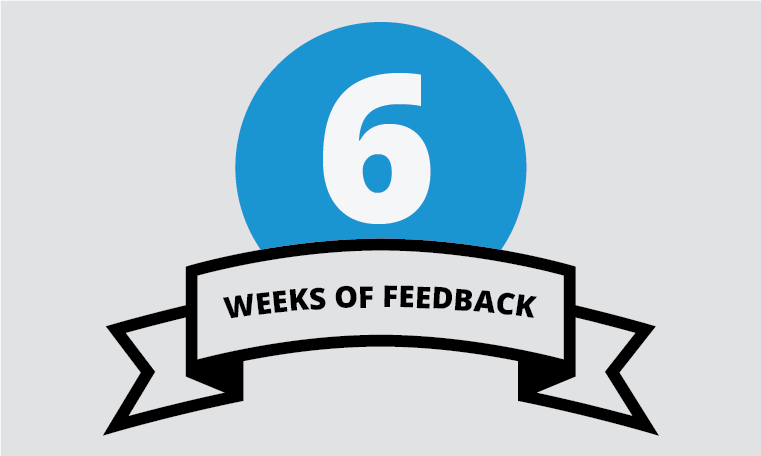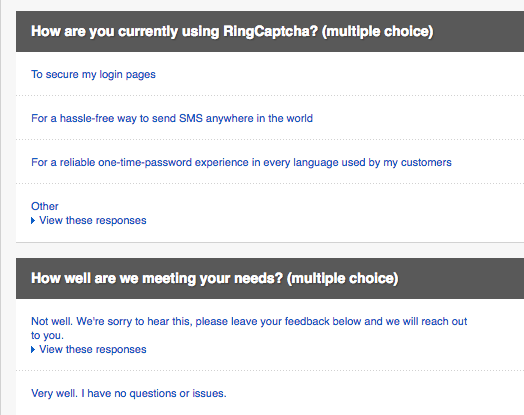
Building a SaaS product can be anything but intuitive. When you first start creating it, you’ll have to make many hard decisions about which features to focus on. And if you’ve already helped build large companies, it’s tempting to prioritize features that will only matter when you have millions of users.
But you are wasting time if you build features that no one will ever use.
You can change this by including customer feedback as part of your product roadmap, much like SMS user authentication service RingCaptcha does. RingCaptcha was built to help their customers verify new signups and prevent ransomware from fake user accounts. But they also listen to feedback so they can design features that will meet their customers’ growing security needs.
One of the ways RingCaptcha learns what features matter most to their customers is through on-site surveys. We sat down with them to discuss how feedback from potential and current customers helps them shape product features to meet customer needs—and how you can apply this to manage your product roadmap.
How feedback from potential customers shapes feature prioritization
You want to deliver a product that solves your target customers’ problems. But the solution you’ve built may not be what they actually need. You must validate your assumptions of what potential customers want against what they need.
RingCaptcha uses Qualaroo surveys on their landing page to determine why potential customers are visiting their site and what they would like to use RingCaptcha’s verification features for. By surveying visitors, they don’t have to guess what features are actually relevant to their potential customers—they can just ask. And they know exactly what features they should prioritize for their audience.

After just six weeks of feedback from these landing page surveys, they’ve learned that people are looking to use one-time password verification for new signups. For example, if a travel booking site like Airbnb signed up a new user, they would want to use one-time password verification to prevent someone from using a fake identity to book a room.
But they also identified a specific buyer persona—fintech companies. These fintech companies focus on verifying secure transactions and blocking fraudulent transactions, like in the case of Bitcoin wallets. For example, if someone wanted to withdraw $500 worth of Bitcoin, you want to make sure that it’s actually the customer’s request and not someone who hacked in.
As a result, they’ve focused on improving features for fintech companies to verify their accountholders. With features like SMS PIN code verification, they can add a layer of security to transactions when someone tries to withdraw currency above a certain threshold.
This example shows how you can notice trends about feature preferences, even in a short timeframe. Like RingCaptcha, you can use surveys on your landing page to determine which features actually solve your potential customers’ problems. And you can focus your time on including features that will attract more customers.
How feedback from current customers improves customer success
A visitor to your site is not as familiar with all the features and capabilities your product has to offer. But your current customers are using it all the time and can tell you what works for them and what doesn’t.
RingCaptcha wanted to find out if current customers were happy with them and what they could improve on. They knew that their current customers were in more of a position to say what features RingCaptcha should be offering next.
SoonHin Khor, chief executive officer of RingCaptcha, said that most customer interaction only happens when they’re in support and just want their problem solved. Customers are usually not in the mood to suggest new product features then. After they have signed in, they are usually in a better mood and are more likely to provide their input.
With this idea in mind, RingCaptcha uses post-login surveys to determine how their current customers are using RingCaptcha and how well they’re meeting their needs. This helps them to see which customers they need to reach out to in order to fix those pain points. They can also see which features are most frequently used by their current customers, whether that’s one-time passwords or securing their login pages.

Here are two ways this survey has already improved customer success:
- One customer was having problems trying to verify a phone number—he could have contacted support, but he used the survey form instead. RingCaptcha reached out to this customer, addressed his issues, and converted him to a paying customer.
- Most of their customers were requesting easier access to support. Because of that feedback, they decided to include live chat service Intercom on their site. “This is probably one of the most helpful things Qualaroo has done for us,” Khor says. Without Qualaroo, live chat “would have been put to the back of the queue.”
Now Intercom has allowed them to quickly engage their customers since they’re always on, rather than responding to emails once a day. They see customer pain points over time and can rapidly address those problems. Just recently, they used live chat to onboard another paying customer.
Both examples show how you can identify and address customer pain points to improve customer success. Like RingCaptcha, you don’t have to wait for your customers to submit a support ticket—you can use their feedback to proactively solve their problems.
How to integrate customer feedback with product validation
RingCaptcha has noticed a lot of customer feedback trends in just 6 weeks. But they know that they still have more product improvements to make down the road.
They plan on using customer feedback to test new feature ideas before they build it. This will help them develop their product roadmap and see which features their customers plan to use. Instead of having their development team waste weeks building something that no one will ever use, they can focus their time on building a product that customers actually want.
RingCaptcha will focus on one new feature they plan to build and, as Khor puts it, ask a question like, “Hey we’re thinking of launching this feature… Would you use this?” If most of their customers respond “yes,” then they’ll build and include that feature.
But even after customers respond “yes” to their survey, they still plan on reaching out. Qualaroo helps them track which logged in customers responded to their survey. So then they can follow up with an email and say something like, “Hey I see that you said you’re interested in this feature. Could you help us understand how you would like to see this feature implemented?”
Like RingCaptcha, you should make your customers feel included in product development and validation. You build stronger relationships with your customers and create features that make them happy. So in the words of Khor, “it gives a better connection with your users—killing a few birds with one stone.”
Use feedback to guide your product roadmap
RingCaptcha learned much by including on-site surveys in their product roadmap strategy. They prioritized features that attracted potential customers, and they fixed customer pain points to retain current customers. And they plan to continue using feedback to test new feature ideas.
Survey feedback has confirmed that RingCaptcha is on the right track so far. But they’re still in the learning process of what customers want to use it for. “We don’t want to get ahead of ourselves,” Khor says. “We know we’ve got a lot of work to do. We’ll take all the yeses and happiness with a pinch of salt.”
You can likewise use RingCaptcha’s techniques to continue guiding your product roadmap. It was instrumental to how RingCaptcha scaled, and it will have a positive impact on customer experience as you continue to grow.
FREE. All Features. FOREVER!
Try our Forever FREE account with all premium features!



